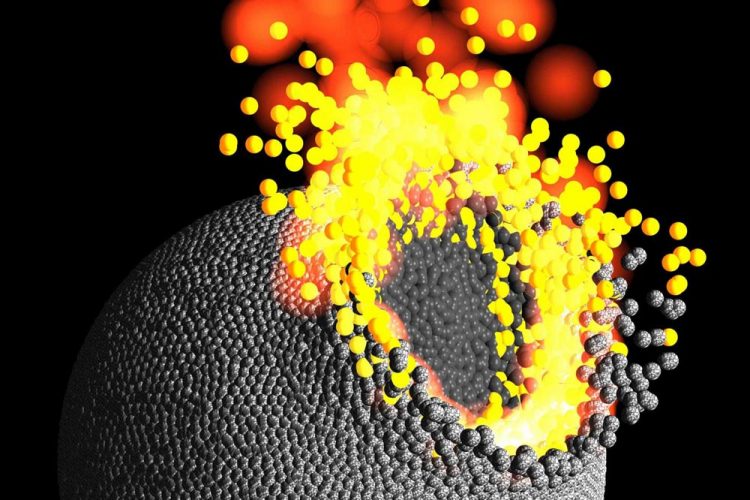Research sheds new light on how Earth and Mars were created

This is a snapshot of a computer simulation of two (relatively small) planets colliding with each other. The colours show how the rock of the impacting body (dark grey, in centre of impact area) accretes to the target body (rock; light grey), while some of the rock in the impact area is molten (yellow to white) or vaporized (red). Credit: Philip J. Carter
Planets grow by a process of accretion – a gradual accumulation of additional material – in which they collisionally combine with their neighbours.
This is often a chaotic process and material gets lost as well as gained.
Massive planetary bodies impacting at several kilometres per second generate substantial heat which, in turn, produces magma oceans and temporary atmospheres of vaporised rock.
Before planets get to approximately the size of Mars, gravitational attraction is too weak to hold onto this inclement silicate atmosphere.
Repeated loss of this vapour envelope during continued collisional growth causes the planet's composition to change substantially.
Dr Remco Hin from the University of Bristol's School of Earth Sciences, led the research which is published today in Nature.
He said: “We have provided evidence that such a sequence of events occurred in the formation of the Earth and Mars, using high precision measurements of their magnesium isotope compositions.
“Magnesium isotope ratios change as a result of silicate vapour loss, which preferentially contains the lighter isotopes. In this way, we estimated that more than 40 per cent of the Earth's mass was lost during its construction.
“This cowboy building job, as one of my co-authors described it, was also responsible for creating the Earth's unique composition.”
The research was carried out in an effort to resolve a decades long debate in Earth and planetary sciences about the origin of distinctive, volatile poor compositions of planets.
Did this result from processes that acted in the mixture of gas and dust in the nebula of the earliest solar system or is it consequence of their violent growth?
Researchers analysed samples of the Earth together with meteorites from Mars and the asteroid Vesta, using a new technique to get higher quality (more accurate and more precise) measurements of magnesium isotope ratios than previously obtained.
The main findings are three-fold:
- Earth, Mars and asteroid Vesta have distinct magnesium isotope ratios from any plausible nebula starting materials
- The isotopically heavy magnesium isotope compositions of planets identify substantial (~40 per cent) mass loss following repeated episodes of vaporisation during their accretion
- This slipshod construction process results in other chemical changes during growth that generate the unique chemical characteristics of Earth.
Dr Hin added: “Our work changes our views on how planets attain their physical and chemical characteristics.
“While it was previously known that building planets is a violent process and that the compositions of planets such as Earth are distinct, it was not clear that these features were linked.
“We now show that vapour loss during the high energy collisions of planetary accretion has a profound effect on a planet's composition.
“This process seems common to planet building in general, not just for Earth and Mars, but for all planets in our Solar System and probably beyond, but differences in the collision histories of planets will create a diversity in their compositions.”
###
Paper:
'Magnesium isotope evidence that accretional vapour loss shapes planetary compositions' by R. Hin, C. Coath, P. Carter, F. Nimmo et al in Nature.
Media Contact
All latest news from the category: Physics and Astronomy
This area deals with the fundamental laws and building blocks of nature and how they interact, the properties and the behavior of matter, and research into space and time and their structures.
innovations-report provides in-depth reports and articles on subjects such as astrophysics, laser technologies, nuclear, quantum, particle and solid-state physics, nanotechnologies, planetary research and findings (Mars, Venus) and developments related to the Hubble Telescope.
Newest articles

Silicon Carbide Innovation Alliance to drive industrial-scale semiconductor work
Known for its ability to withstand extreme environments and high voltages, silicon carbide (SiC) is a semiconducting material made up of silicon and carbon atoms arranged into crystals that is…

New SPECT/CT technique shows impressive biomarker identification
…offers increased access for prostate cancer patients. A novel SPECT/CT acquisition method can accurately detect radiopharmaceutical biodistribution in a convenient manner for prostate cancer patients, opening the door for more…

How 3D printers can give robots a soft touch
Soft skin coverings and touch sensors have emerged as a promising feature for robots that are both safer and more intuitive for human interaction, but they are expensive and difficult…





















